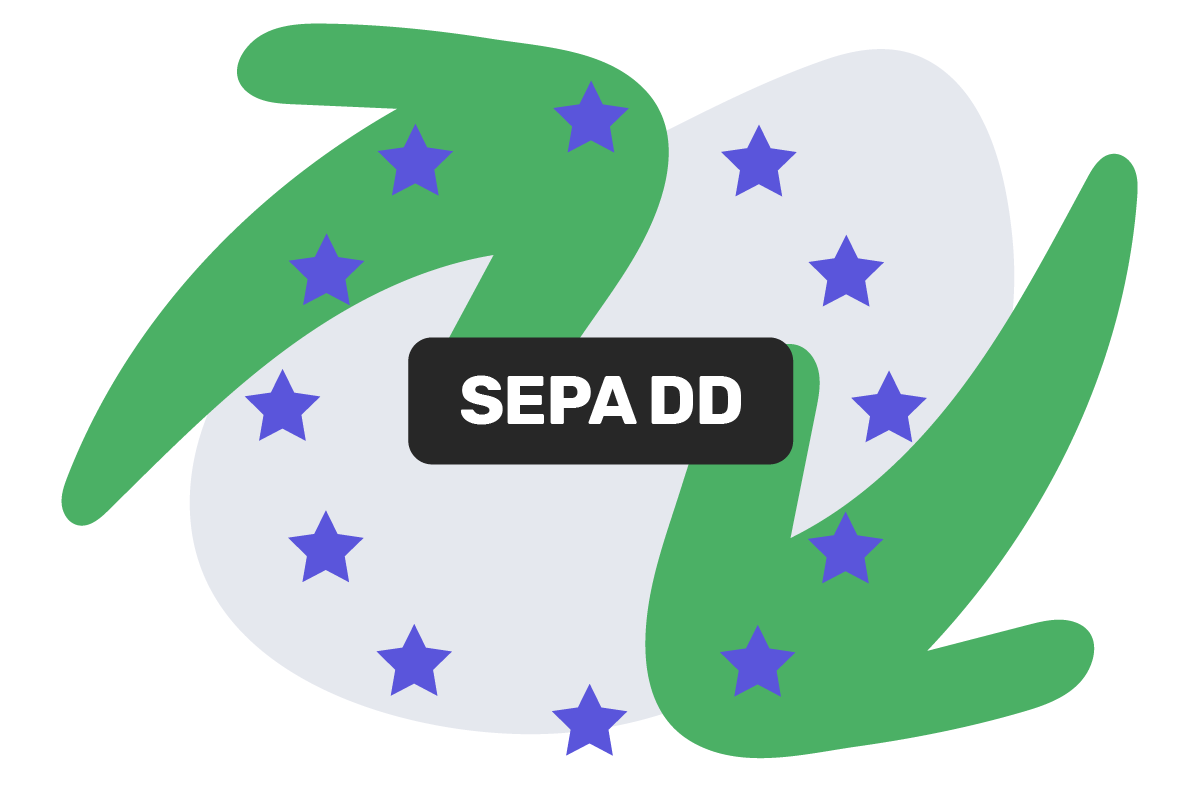Article was updated on 26.11.2024
SEPA Direct Debit (SDD) is a pre-authorized payment option available in the eurozone. It works pretty much like all the other direct debit transactions, but only in euros within the SEPA area. Genome’s team will explain SEPA Direct Debit origination, the process itself, and the advantages of such transfers.
What is SEPA Direct Debit?
SEPA Direct Debit payments are a payment method under the Single Euro Payments Area (SEPA) based in the European Union that allows businesses to receive payments in euros directly from a customer’s bank account based on prior authorization (mandate).
SEPA Direct Debit payments work via two business schemes: SEPA Core Direct Debit (SDD Core) and SEPA B2B Direct Debit (SDD B2B).
Any bank or financial provider supporting SEPA Direct Debit is obliged to offer the SDD Core scheme. SDD B2B is not mandatory. SEPA Core Direct Debit is designed for individuals’ bank accounts, and the B2B version is for business only.
Both Core and B2B have the same processing time. According to payment terms, the funds should reach the account within 14 days after the payer was charged. In practice, money appears in the account within 5 business days. Similarly, in both schemes, the biller is in charge of keeping the completed mandate and initiating changes (after the payer’s request) if needed.
SEPA Direct Debit payments are hardly comparable to other payment methods, except for other direct debit schemes used around the world, like direct debits provided via American ACH.
Countries in the SEPA list 2024
The participating nations include EU members and several non-EU states that use SEPA payments and cooperate under SEPA rules to facilitate seamless transactions for businesses and individuals across borders. All the SEPA countries can be classified into 3 types:
EU countries using the euro:
Austria, Belgium, Croatia, Cyprus, Estonia, Finland, France, Germany, Greece, Ireland, Italy, Latvia, Lithuania, Luxembourg, Malta, Netherlands, Portugal, Slovakia, Slovenia, and Spain. This list also includes special territories and parts of EU members located outside Europe, such as the Canary Islands or the French overseas region.
EU countries not using the euro:
Bulgaria, Czech Republic, Denmark, Hungary, Poland, Romania, and Sweden. These countries participate in euro transactions while maintaining their local currencies for domestic use.
Non-EU members:
Andorra, Iceland, Liechtenstein, Monaco, Norway, San Marino, Switzerland, the United Kingdom (including Gibraltar), and Vatican City.
Open an account
in Genome online
How do SEPA Direct Debit payments work?
The whole process of setting up SEPA Direct Debit payments can be divided into a few stages. Your financial institution takes care of all the hassle if you’re both a payer and a biller.
The first step is to get your client to sign a mandate. Note that a same-debtor mandate allows a payer to use a single authorization to make multiple payments to the same creditor. You can contact your bank for help with this. Usually, mandates are sent via email, but some customers prefer to have them printed out and sent to them directly.
After the mandate is ready, you can start accepting the SDD payments under the best scheme for you and the people/companies from which you receive funds. Even though most of the steps are controlled by your financial provider, we’ll go through all of them so that you know what the whole process looks like.
SEPA Direct Debit payment notices should also be sent each time the funds are taken from the payer’s account. If the sum is the same every time, such notification can be sent closer to the direct debit date. However, if the amount changes, it’s worth sending the notice before the incoming debit payment date so that the person is aware of the amendments.
The payer will also receive a notification as soon as the transaction is successful or failed.
Benefits of using SEPA Direct Debit
There are a few significant pros to SEPA Direct Debit payments compared to the transfers you initiate yourself.
Reducing cost
One of the main selling points of SEPA Direct Debit payments is their cost: SEPA Direct Debit payments costs typically range from €0.05 to €0.20 per transaction, depending on the bank and volume of transactions processed. In contrast, SWIFT transfers often incur fees between €10 and €50 per transaction, with additional intermediary and currency conversion costs.
Cross-border transactions with SEPA Direct Debits are priced the same as domestic ones within SEPA, eliminating the premium charges and foreign exchange conversion that often accompany other payments or wire transfers.
Convenient and streamlined payments
Another obvious benefit of SEPA Direct Debit payments is convenience. Once the mandate is signed, you do not have to instruct transfers every month and enter all bank details risking making a mistake. The funds are withdrawn from your account automatically.
Thus, you do not have to worry about forgetting to pay or being late with your transactions. A direct debit is a great option for paying bills, as well as one of the solutions for company cash management considerations.
Ensuring security and safety
Let’s talk about safety when making direct debit payments in EUR. From both the biller’s and payer’s sides, it’s their financial institutions that are in charge of all the financial operations when it comes to direct debit.
That is why PSPs only cooperate with reliable and trustworthy billers. In case something goes wrong, the biller’s PSP will be responsible for covering the refund. Thus, they double-check their clients, too. For the payer, it’s an additional layer of security as the chances of dealing with fraudsters are very low.
If you’re still not sure if you want to use direct debit transactions, you can stick to making regular transfers. In Genome, we support both SEPA Instant/Credit and SWIFT payments, as well as internal transfers that are free and instant.
Open an account
in Genome online
When to use SEPA Direct Debits?
1. Subscriptions and memberships. Transfers via SEPA Direct Debit consolidate business capabilities to collect regular payments, such as for utilities, subscriptions, memberships, and insurance premiums. The automated, recurring nature of a SEPA Direct Debit scheme simplifies billing processes, reduces administrative overhead, and ensures timely payments from your bank account.
Example use cases. Streaming services, bills, gym memberships, other services with recurring payments.
Benefit. Businesses can set up automatic withdrawals, reducing the need for manual intervention.
2. Cross-border payments. SEPA Direct Debit facilitates efficient cross-border euro payments without additional fees or complexities typically associated with international transfers. It enables smooth, standardized payment processing between SEPA countries, which is especially beneficial for companies operating across multiple European nations.
Example use cases. E-commerce business in Germany that receives payments from customers from France or Spain.
There are no extra charges for successful Direct Debits within SEPA compared to traditional bank transfers while accepting payments from European suppliers and customers.
3. Reducing administrative costs SEPA Direct Debit transactions reduce the time and effort required for manual invoicing, payment collection, and reconciliation. Once this payment method is set up, minimal intervention is required to collect payments into your bank account, resulting in lower operational costs.
Example use cases. Large organizations with numerous small transactions (e.g., rent collections, subscription billing). Automated payment documentation for local tax authorities or charity accounts.
Benefit. Significant cost savings in administrative work, especially for businesses with high transaction volumes.
4. Customer-friendly payment experience. SEPA Direct Debit payments provide customers with a seamless and automatic payment experience. Once the mandate is set up, customers don’t have to worry about missing payments.
Example use cases. Regular services like cloud storage, or software tools.
Benefit. Customers don’t have to remember payment deadlines, leading to fewer late fees and a smoother overall service experience, resulting in reduced numbers of payment refunds.
When not to use SEPA Direct Debits?
Non-euro currency accounts or non-SEPA transactions. SEPA Direct Debits originated in the European Union and is restricted to euro-denominated payments and SEPA member countries. It cannot handle payments in other currencies or countries outside SEPA. For this purpose, SWIFT would be the right option.
Small transaction amounts. For microtransactions, the fixed costs of setting up direct debit may outweigh its benefits, making it less cost-effective. Try mobile wallets (e.g., Google Pay or Apple Pay) instead.
Urgent payments. SEPA Direct Debit payments are processed within a 1–2 business day window, which is unsuitable for time-sensitive payments. Use instant SEPA payments for near-real-time processing within SEPA.
SEPA transfers and Genome
Although Genome doesn’t offer a SEPA Direct Debit scheme, we have other transfer options. Our clients can make SEPA payments to all the SEPA countries, with both credit and instant SEPA transfer options available.
You can also start a business account and access international transfers such as SWIFT and more! Regularly pay suppliers and business partners with ease.
You can also start multi-currency business accounts in EUR, USD, GBP, PLN, CHF, JPY, or CAD in seconds! Additionally, you can issue multiple virtual and physical Visa cards and link a card to a business account for convenient payments around the world!
Open an account
in Genome online
Key takeaways
SEPA Direct Debit plays an important role in streamlining payments within the SEPA area. It offers a standardized, secure, and cost-effective way to process both domestic and cross-border regular payments. By understanding how to set up and pay euro direct debits, businesses can reduce costs, improve cash flow, enhance customer experience, and increase overall operational efficiency.
FAQs
What is the difference between SEPA Direct Debit and regular direct debit?
SEPA Direct Debit is a standardized payment method for euro-denominated transactions for bank accounts within the SEPA zone, offering seamless cross-border payments. Regular direct debits are typically domestic and may have varying rules and fees depending on the country or bank, making them less efficient for international transactions.
How can I set up a SEPA Direct Debit mandate?
To set up a SEPA Direct Debit mandate, the payer must authorize the payee to collect payments directly from their bank account. This is usually done through signed SEPA Direct Debit mandates, either online or in paper format, which must be submitted to the bank or payment service provider. Check the payment terms beforehand and note that refund terms vary between banks.
What are the consumer rights and protections under SEPA Direct Debit?
Consumers benefit from strong protections under SEPA Direct Debit. The period established to dispute unauthorized transactions is 13 months. You can request refunds for incorrect or duplicate charges within 8 weeks. Additionally, the mandate can be revoked at any time, providing consumers with control over their payments.
How do I cancel a SEPA Direct Debit?
To cancel a SEPA Direct Debit, the payer must inform their bank and the payee in writing, revoking the mandate. The bank will stop future payments based on the canceled mandate, ensuring no further transactions are processed from the payer’s bank account.
What happens if there is an error in a SEPA Direct Debit transaction?
If an error occurs in a SEPA Direct Debit, consumers can request a refund from their bank within 8 weeks for unauthorized or incorrect payments. In cases of incorrect amounts or duplicate transactions, the error will be corrected, and the money will be refunded.






